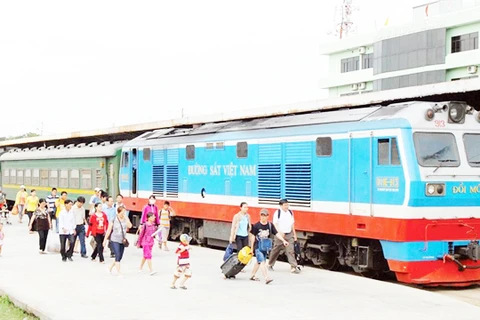HCM City (VNA) – The Minister of Transport has assigned its railway project management unit to make a prefeasibility study of the 10-billion-USD Ho Chi Minh City-Can Tho railway project.
Under the detailed planning of the project passed in 2013, the route is designed to have a length of 173.6km with 14 stations, starting from the An Binh cargo station in the southern province of Binh Duong’s Di An town, then the passenger station in Ho Chi Minh City’s Binh Chanh district, and ending in Can Tho’s Cai Rang district.
However, recently the Phuong Nam Science and Technology Institute (PNSTI) submitted to the HCM City People’s Committee and the Ministry of Transport its final report on adjustments to the project after seven years of research.
Per the report, the rail line will run along the right-side corridor of the HCM City-Trung Luong and Trung Luong – My Thuan expressways. In the initial plan, it will cross crowded residential areas and industrial parks, which may result in difficult site clearance and higher expenses for compensation.
The adjustment will also shorten the total length of the route by 5km, saving about 200 million USD in construction costs.
The latest plan sees the 134.9km railway crossing five localities – HCM City, Long An, Tien Giang, Vinh Long and Can Tho. With nine urban stations, it will start from the Tan Kien station in HCM City and end at the Can Tho station in the city of the same name. In addition, there will be a 44km branch route from the Thanh Phu station in Long An province to the Hiep Phuoc port and Long An international port.
The maximum speeds for goods and passenger trains on the route will be 150km and 200km per hour, respectively.
The project has so far attracted investment from 20 international sources, including the US, European nations and international financial organisations.
Currently, it takes up to five hours to go from HCM City to Can Tho by road due to traffic congestion. The high-speed rail line is expected to reduce the travel time to about 45 minutes.
According to a study from the Japan International Cooperation Agency (JICA), the annual volumes of goods and passengers transported between the Mekong Delta and HCM City will reach 147.5 million tonnes and 46.5 million passengers in the future./.
Under the detailed planning of the project passed in 2013, the route is designed to have a length of 173.6km with 14 stations, starting from the An Binh cargo station in the southern province of Binh Duong’s Di An town, then the passenger station in Ho Chi Minh City’s Binh Chanh district, and ending in Can Tho’s Cai Rang district.
However, recently the Phuong Nam Science and Technology Institute (PNSTI) submitted to the HCM City People’s Committee and the Ministry of Transport its final report on adjustments to the project after seven years of research.
Per the report, the rail line will run along the right-side corridor of the HCM City-Trung Luong and Trung Luong – My Thuan expressways. In the initial plan, it will cross crowded residential areas and industrial parks, which may result in difficult site clearance and higher expenses for compensation.
The adjustment will also shorten the total length of the route by 5km, saving about 200 million USD in construction costs.
The latest plan sees the 134.9km railway crossing five localities – HCM City, Long An, Tien Giang, Vinh Long and Can Tho. With nine urban stations, it will start from the Tan Kien station in HCM City and end at the Can Tho station in the city of the same name. In addition, there will be a 44km branch route from the Thanh Phu station in Long An province to the Hiep Phuoc port and Long An international port.
The maximum speeds for goods and passenger trains on the route will be 150km and 200km per hour, respectively.
The project has so far attracted investment from 20 international sources, including the US, European nations and international financial organisations.
Currently, it takes up to five hours to go from HCM City to Can Tho by road due to traffic congestion. The high-speed rail line is expected to reduce the travel time to about 45 minutes.
According to a study from the Japan International Cooperation Agency (JICA), the annual volumes of goods and passengers transported between the Mekong Delta and HCM City will reach 147.5 million tonnes and 46.5 million passengers in the future./.
VNA


























